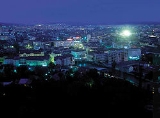
Cluj-Napoca
Overview
Medieval Latin
Medieval Latin was the form of Latin used in the Middle Ages, primarily as a medium of scholarly exchange and as the liturgical language of the medieval Roman Catholic Church, but also as a language of science, literature, law, and administration. Despite the clerical origin of many of its authors,...
: Castrum Clus, Claudiopolis; , Kloiznburg), commonly known as Cluj, is the fourth most populous city in Romania
Romania
Romania is a country located at the crossroads of Central and Southeastern Europe, on the Lower Danube, within and outside the Carpathian arch, bordering on the Black Sea...
and the seat of Cluj County
Cluj County
Cluj ; is a county of Romania, in Transylvania, with the capital city at Cluj-Napoca.-Demographics:In 2007, it had a population of 692,316 and a population density of 104/km².*Romanians – 80%*Hungarians – 17.5%*Roma – 2.5%-Geography:...
in the northwestern part of the country. Geographically, it is roughly equidistant from Bucharest
Bucharest
Bucharest is the capital municipality, cultural, industrial, and financial centre of Romania. It is the largest city in Romania, located in the southeast of the country, at , and lies on the banks of the Dâmbovița River....
(441 km / 276 mi), Budapest
Budapest
Budapest is the capital of Hungary. As the largest city of Hungary, it is the country's principal political, cultural, commercial, industrial, and transportation centre. In 2011, Budapest had 1,733,685 inhabitants, down from its 1989 peak of 2,113,645 due to suburbanization. The Budapest Commuter...
(409 km / 256 mi) and Belgrade
Belgrade
Belgrade is the capital and largest city of Serbia. It is located at the confluence of the Sava and Danube rivers, where the Pannonian Plain meets the Balkans. According to official results of Census 2011, the city has a population of 1,639,121. It is one of the 15 largest cities in Europe...
(465 km / 291 mi).

